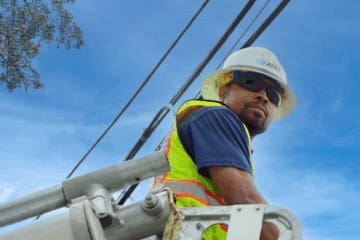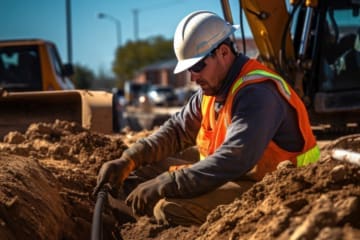States are ramping up activity around the Broadband, Equity, Access and Deployment (BEAD) program and with all the states submitting initial proposals at the end of last year, we are one step closer towards turning $42.5 billion into connections for Americans. Before we know it, BEAD-funded projects will be underway – and preparation today must be done so that we can connect as many Americans as possible when the time comes.
- Back in December, Louisiana became the first state to have its BEAD Initial Proposal approved by the NTIA.
Late last summer, I wrote a piece emphasizing the importance of these preparations – particularly building supply chain and workforce pipelines. The sentiment behind my piece explains why I am delighted to be able to celebrate the passing of another key road marker with the Administration’s approval of a limited and targeted Build America, Buy America (BABA) waiver for BEAD deployments.
Providers now have the guidance they need to meet the BABA requirements and accompany their investments in infrastructure with investments in American companies and American workers.
- The NTIA expects close to 90% of BEAD costs for network materials to be spent on components manufactured in the U.S.
It’s a value we align with wholeheartedly, as we always strive to support American companies, suppliers, and workers. Over the past two years, we’ve been preparing to comply with BABA, collaborating with longtime partners on initiatives to position us with both the supplies and workforce to the build the networks of the future.
Boosting Domestic Manufacturing Capabilities.
When we expand our fiber network, we often go to Corning Incorporated – one of the largest American manufacturers of fiber-optic cables. Our ability to serve over 26 million customers with AT&T Fiber is thanks in large part to the fiber-optic cables that are primarily made in their U.S. manufacturing facilities.
With BEAD funding on the way, we are doubling down on our relationship with Corning, to increase manufacturing and get ready for the demand ahead.
Not long after the Infrastructure Investment and Jobs Act (IIJA) and BEAD program was signed into law, we expanded our work with Corning as they announced their own investment in fiber optic cable manufacturing facilities – part of the $500 million Corning has invested in fiber and cable manufacturing since 2020. The move will translate to more domestic manufacturing power and more American-made network materials. Since our announcement with Corning, we’ve been pleased to see others in the industry make their own investments to further boost domestic manufacturing capabilities.
Last summer, AT&T attended an event in which we saw Nokia announce a partnership with Sanmina to expand manufacturing in Sanmina’s facilities in Kenosha, Wisconsin. The facility will manufacture optical line termination cards, another essential network part, helping the entire broadband industry comply with BABA.
Efforts like the ones we’ve engaged in and seen over the past 2+ years are absolutely necessary if we’re going to turn network blueprints into physical infrastructure connecting communities.
Similarly, our materials are only as valuable as the workers who will build our networks, which is why we’ve been investing in people the same way we’ve been investing in our supplies and materials.
Investing in People to Support America’s Workforce.
While it’s important for as much equipment as possible to be made in the U.S., when you look at the overall spending for broadband deployment, approximately 70% of that is for labor1.
What that means is that at the same time we’re shoring up American-made network materials, we have to be thinking about attracting and retaining enough workers who can build networks with our newly manufactured supplies. And the best way to do that is by investing in people, to set them up for success in the field.
- As one of America’s largest union employers, we created a taskforce with the Communications Workers of America to design a technician apprenticeship program for AT&T employees.
With this in mind, we took our work with Corning a step further, going beyond supply manufacturing to also create a Fiber Optic Training Program within their facilities in North Carolina.
Underway today, trainees are receiving hands-on experience from industry experts who know how to equip them with the skills they need to enter the workforce. On top of that, graduates of the program will be able to train others as we look to upskill thousands of American workers within the next 5 years.
To reach even further with these trainings, we’ve brought the Corning Curriculum to classrooms. We’re collaborating with the Louisiana Community and Technical College System (LCTCS) on courses offering students industry-based credentials and skills to qualify for high-wage broadband jobs that will be in high demand once BEAD funding is in use.
- We have expanded this model and are also teaming up with Cape Fear Community College in North Carolina to include fiber optic training programs in their curriculum.
These efforts reflect our belief that in order to make the most of historic investments in infrastructure, we’ll need to invest in people as well. By building these different workforce pipelines – throughout the industry, educational institutions and our own business – we’re cultivating the American workforce needed to deploy networks over the next few years.
The Bottom Line.
As we gear up to deploy broadband networks using BEAD dollars, the actions we take today will determine how efficiently and effectively we utilize this historic investment. The recent approval of the NTIA’s BABA waiver for BEAD should serve as added motivation for industry players and local governments to continue their efforts to put everyone in a position to have American-made materials and American workers behind BEAD-funded networks.
We look forward to continuing the momentum we have built over the past several years to produce more materials and train more workers so we’re ready when the time comes.
1Fiber Broadband Association, 2023 Fiber Deployment Cost Study





